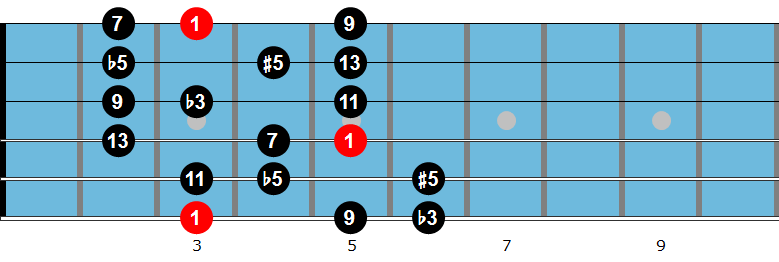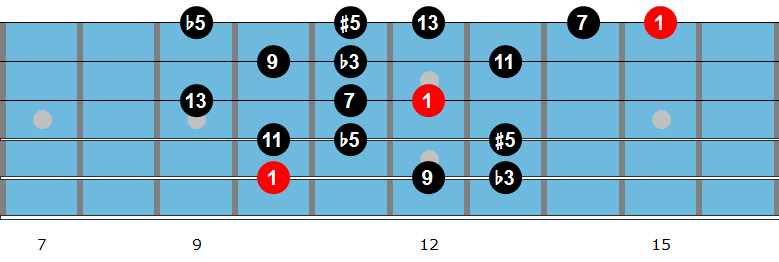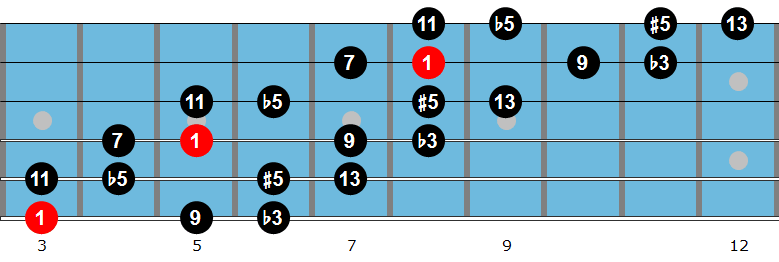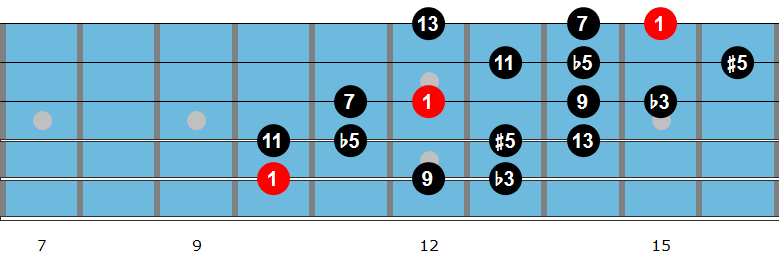The diminished scale is a symmetrical scale that is built by alternating whole steps and half steps and is used to solo over diminished seventh chords. Dim7 chords are not as commonly used as m7, dominant 7th or maj7 chords in jazz standards, but when they do pop up, they have a tendency to handcuff beginning improvisers. This lesson will introduce you to the diminished scale, which will allow you to confidently and musically solo over Dim7 chords the next time you encounter one in a jazz tune.
This lesson will explain how to build, play, and solo with the diminished scale, as well as provide you with practice patterns, arpeggio patterns, and sample licks to help take your Dim7 soloing phrases to the next level.
What Is The Diminished Scale?
The diminished scale is an eight-note scale that is built by picking a tonic note, and then alternating whole steps and half steps from that starting note. Because of that it is also commonly referred to as the whole-half diminished scale.
To help you visualize how the diminished scale is constructed, here is a chart that lays out the interval structure for this scale, as well as showing how the whole (W) and half (H) steps are used to create this octatonic scale.
| Diminished Scale | 1 | 9 | b3 | 11 | b5 | #5 | 13 | 7 | 1 |
|---|---|---|---|---|---|---|---|---|---|
| W | H | W | H | W | H | W | H |
The diminished scale is used to solo over diminished 7 (Dim7) chords.
The diminished scale is different from the dominant diminished scale, which alternates half and whole steps and is used to solo over dominant 7b9 chords.
When first exploring diminished scales on guitar, it is easy to confuse the two scales. To help keep these two scales separate in your head, and on the fretboard, here is a quick way to think of each scale:
- Dominant 7b9 diminished = half-whole
- Dim7 diminished = whole-half
Diminished Scale Fingerings
To begin your study of diminished scale fingerings, here is a two-octave shape from the 6th string that stays in position, which means that there is no shifting up or down the neck as you play this scale on the guitar.
This scale is written from the root note G, and so it is called a G diminished scale. Once you can play this fingering, or any fingering in this lesson, in the given key, make sure to move it to other keys.
Listen & Play Along

You can also play an in-position G diminished scale from the 5th-string root note, which you can see and hear in the following example.
Listen & Play Along

Moving on, here is a G diminished scale from the 6th string that shifts up the neck, which is an effective fingering for moving between positions on the guitar.
Listen & Play Along

The final fingering in this lesson is a G diminished scale from the 5th string that shifts up the fingerboard.
Listen & Play Along

Once you can play one, or all, of these diminished scale fingerings, put on a Dim7 backing track and begin to solo over that chord using the fingerings from this lesson.
As well as learning to play these scales on the guitar, it is also important to take these shapes to the improvisational side of your studies to prepare yourself for applying them to jazz tunes and progressions.
Diminished Scale Practice Patterns
Next, you will learn to play four variations of a common jazz scale pattern called diatonic thirds. Here it is applied to the G diminished scale from the 6th string root. Any of the patterns in this section of the lesson can be applied to any key, and to any fingering, 6th, and 5th string roots.
To begin, here are ascending 3rds through the G diminished scale.
Listen & Play Along

Moving on, here are descending 3rds played over a G diminished scale.
Listen & Play Along

The next practice pattern variation features the first 3rd ascending followed by the second 3rd descending. This is referred to as alternating 3rds when applied to scale practice.
Listen & Play Along

The final practice pattern is a reversal of the pattern you just learned, only now you are playing the first 3rd descending, followed by the second 3rd ascending.
Listen & Play Along

Diminished Scale Arpeggios
When studying diminished scales, one of the most interesting concepts that you can explore is the use of both Dim7 and dominant 7th arpeggios through this scale.
Because you can solo over Dim7 chords with the diminished scale, it is no surprise that you can use Dim7 arpeggios built from this scale in your soloing lines, but many of us may not yet be aware that you can also use dominant 7th arpeggios from the scale to solo over Dim7 chords.
To understand this concept, let’s break down a C diminished scale by first looking at its notes:
| C diminished scale | C | D | Eb | F | Gb | G# | A | B | C |
|---|
When you build arpeggios from the 1st, 3rd, 5th, and 7th notes of this scale you produce 4 Dim7 arpeggios:
- Cdim7 = C Eb Gb A
- Ebdim7 = Eb Gb A C
- Gbdim7 = Gb A C Eb
- Adim7 = A C Eb Gb
Now, let’s take a look at the four arpeggios that you build when starting from the 2nd, 4th, 6th and 8th notes of the scale, which are all dominant 7th arpeggios:
- D7 = D F# (Gb) A C
- F7 = F A C Eb
- Ab7 = Ab (G#) C Eb Gb
- B7 = B D# (Eb) F# (Gb) A
To see these arpeggios on the guitar, here are the ascending versions of each arpeggio in a C diminished scale:
Listen & Play Along

Here is a G diminished scale from the 6th string with the ascending arpeggios applied to this fingering:
Listen & Play Along

Diminished Scale Licks
To finish this introduction to the diminished scale, here are three licks that you can study and apply to your playing when soloing over Dim7 chords.
The first lick uses 3rds to solo over a Dim7 chord, in a four-bar phrase.
Listen & Play Along

Moving on, the second lick uses a Bb diminished scale to solo over a Bbdim7 chord in a iiim7-bIIIdim7-iim7-V7 progression.
Listen & Play Along

The final lick in this lesson uses the same Bb diminished scale over a Bbdim7 chord, though in this case, you will draw from the arpeggios in that scale to build your line.
Listen & Play Along

The diminished scale is often a bit tricky to study on the guitar, compared to the major scale modes which are usually quicker and easier to work out on the fretboard. But, by working out various fingerings and practice patterns, you will ensure that you are ready to nail any Dim7 chord in your soloing lines the next time you run into one.
More Guitar Scale Lessons
The post The Diminished Scale appeared first on Jazz Guitar Online | Free Jazz Guitar Lessons, Licks, Tips & Tricks..
from Jazz Guitar Online | Free Jazz Guitar Lessons, Licks, Tips & Tricks. https://ift.tt/2xBq6Dy


No comments:
Post a Comment